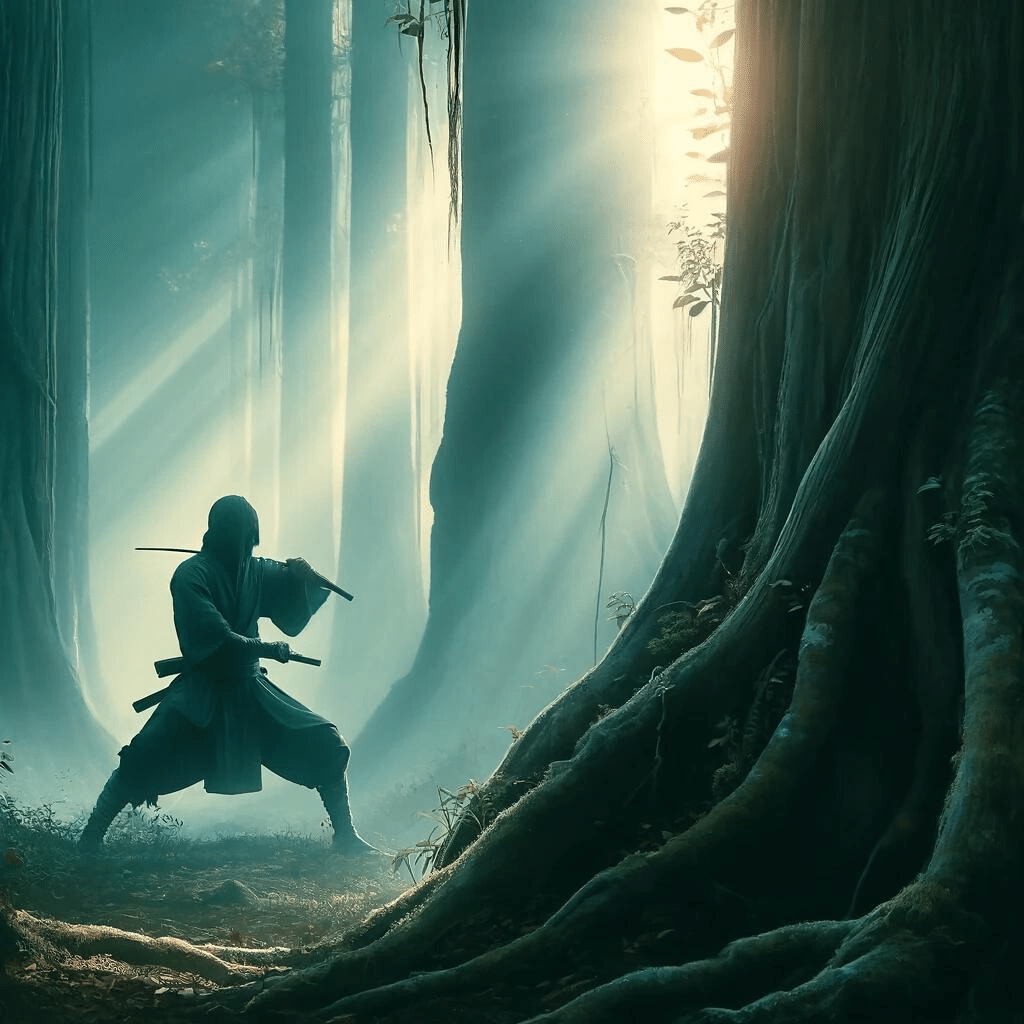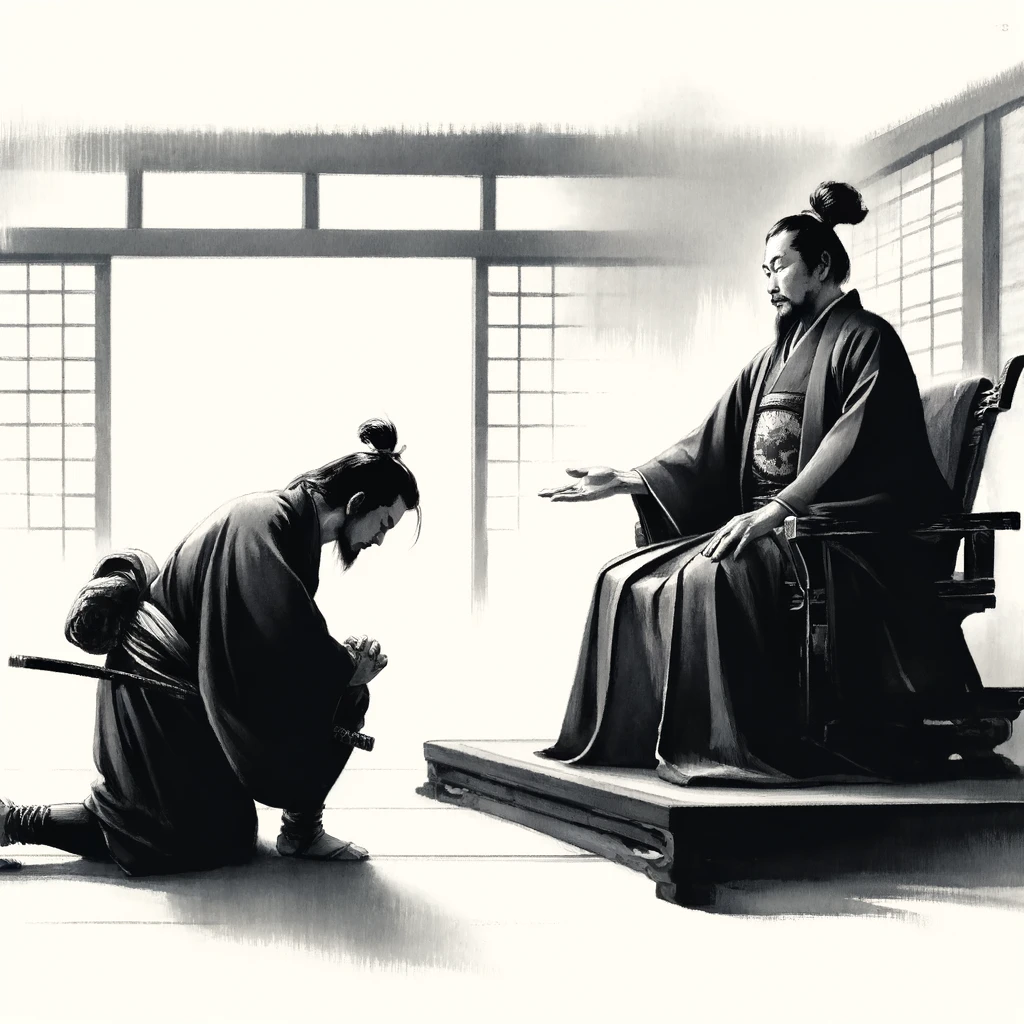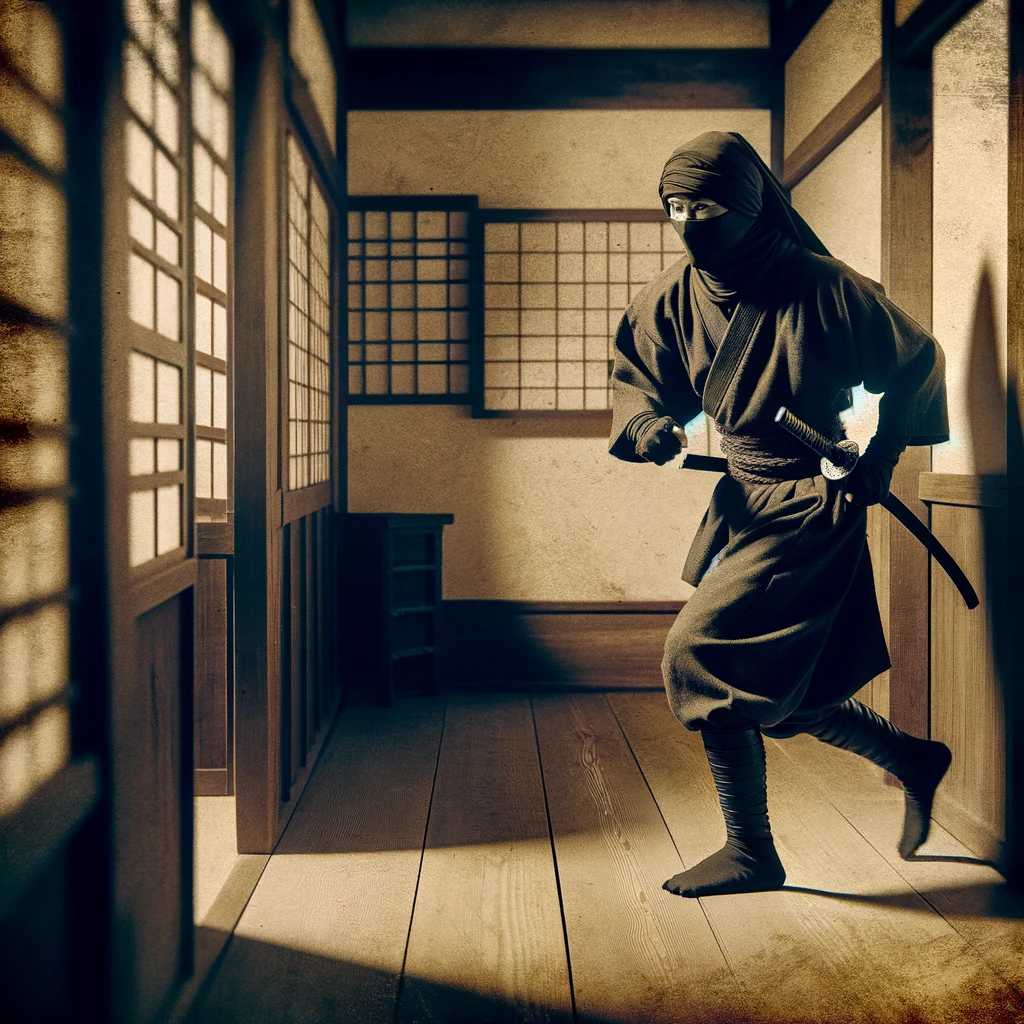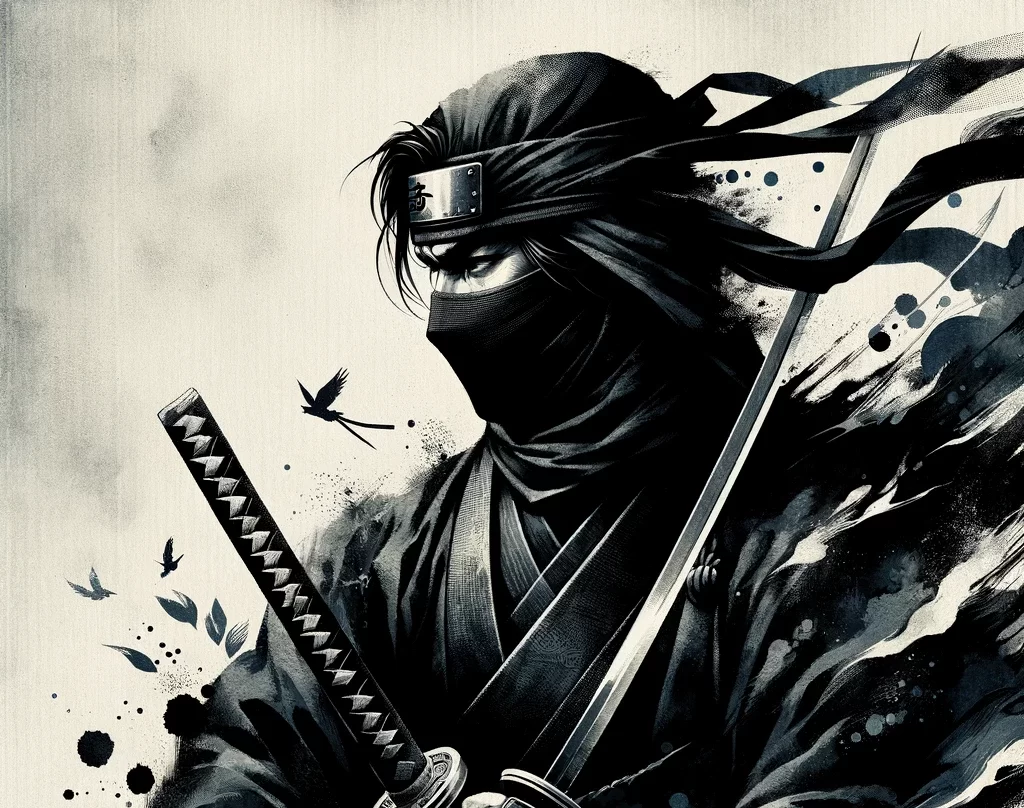Introduction
Hattori Hanzo is a name that resonates through centuries of Japanese history, embodying the enigmatic spirit of the samurai and the strategic prowess of the ninja. Revered as a master of stealth, tactics, and unwavering loyalty, Hanzo’s legacy continues to captivate those who delve into the tales of Japan’s feudal era. He served Tokugawa Ieyasu, one of Japan’s most influential shoguns, with remarkable dedication and cunning, solidifying his place not only as a historical figure but also as a legend whose influence reaches far beyond his time. Whether seen through the lens of history or through portrayals in modern popular culture, Hattori Hanzo remains a fascinating figure whose story speaks to the values of strategy, loyalty, and the timeless art of warfare. This blog post seeks to explore his journey from a young warrior to an immortal legend, unraveling the layers of myth and truth that have made his name synonymous with the mystery of the ninja.
Hattori Hanzo – Background and Early Life
Hattori Hanzo, born in 1542, was a pivotal figure in the Sengoku period, a time of social upheaval, war, and intrigue in Japan. He was descended from the prestigious Hattori family, a lineage known for their martial prowess and service as samurai. From a young age, Hanzo was immersed in the art of warfare and strategy, learning not only the way of the samurai but also the covert techniques of ninjutsu, which would later define much of his legendary status.
Growing up in the province of Iga, a region famed for its skilled ninjas, Hanzo was trained in the techniques that made the ninjas of Iga feared and respected throughout Japan. This training included espionage, sabotage, and assassination—skills that were crucial in the constant power struggles of the time.
The era was marked by the daimyo (feudal lords) constantly vying for power, which shaped Hanzo into a warrior adept in both conventional and unconventional warfare. His early years were not just about training but also about understanding the complexities of political alliances and the importance of loyalty—a trait that would later define his service to Tokugawa Ieyasu and earn him his legendary status. As a young man, Hanzo quickly distinguished himself with his bravery and skills, setting the stage for his later exploits and his enduring legacy as one of Japan’s most iconic figures.
Hattori Hanzo – Training and Skills

Hattori Hanzo’s training was rooted in the distinct martial traditions of his native Iga province, a region renowned for its mastery of ninjutsu. This training began at an early age and encompassed a broad spectrum of martial disciplines. As a member of the samurai class, Hanzo was proficient in the traditional skills expected of a warrior: swordsmanship, archery, horsemanship, and hand-to-hand combat. His command of the katana and yari (spear) earned him respect as a formidable warrior on the battlefield.
However, what truly set Hanzo apart were his skills as a ninja. He was adept at guerrilla tactics, sabotage, and psychological warfare, skills that were vital in the politically unstable Sengoku period. The ninjas of Iga were famous for their ability to navigate rugged terrain stealthily and to conduct reconnaissance missions undetected. Hanzo excelled in these arts, combining physical agility with cunning strategy. He learned to blend seamlessly into any environment and to manipulate his surroundings, whether moving silently through dense forests or using clever disguises to gather intelligence.
Furthermore, Hanzo’s leadership qualities emerged early on. His understanding of strategy extended beyond individual combat to orchestrating coordinated strikes and diversions, often employing a network of informants and spies. He understood the value of precise information in warfare and was known for his ability to foresee enemy moves and outmaneuver them.
In addition to these martial skills, Hanzo honed his sense of loyalty and discipline. His unwavering devotion to Tokugawa Ieyasu was a testament to the samurai code of bushido. His strategic thinking and ability to lead his men through the most challenging situations proved invaluable during his service. Thus, Hanzo’s training and skills were not just a reflection of his martial prowess but also of his dedication to a cause greater than himself, cementing his place as a master strategist and warrior.
Hattori Hanzo – Service to Tokugawa Ieyasu

Hattori Hanzo’s legacy is most closely linked to his unwavering service to Tokugawa Ieyasu, a pivotal figure who would later establish the Tokugawa shogunate, ushering in over 250 years of peace in Japan. Hanzo’s relationship with Ieyasu began during the Sengoku period, when Japan was engulfed in a series of regional conflicts among competing daimyo.
Hanzo distinguished himself early on as a trusted and indispensable retainer to Ieyasu. His deep understanding of strategy, combined with his ability to move swiftly and undetected, made him the ideal operative for high-stakes missions. One of his most celebrated feats was the daring rescue of Ieyasu’s family in 1582, following the sudden death of Oda Nobunaga, a key ally of Ieyasu. Nobunaga’s death left Ieyasu vulnerable, and he faced immediate threats from rival clans seeking to capitalize on the power vacuum.
During this critical time, Hanzo marshaled his ninja forces to guide Ieyasu and his family safely across the treacherous terrain between Kansai and Mikawa, evading enemy patrols and checkpoints along the way. Hanzo’s leadership and knowledge of the region were crucial, as he navigated the group through perilous mountain paths and used guerrilla tactics to mislead and outmaneuver their pursuers. His success in ensuring Ieyasu’s safe passage demonstrated his strategic brilliance and earned him the eternal gratitude of his lord.
Following this daring rescue, Hanzo continued to serve Ieyasu with absolute loyalty, organizing and leading covert operations that helped neutralize rivals and expand Tokugawa influence. He played a key role in consolidating power for Ieyasu, using intelligence networks to anticipate threats and assisting in critical sieges that would pave the way for Ieyasu’s ultimate rise to power.
Hanzo’s contribution to Ieyasu’s eventual victory at the Battle of Sekigahara in 1600 was also significant. His expertise in unconventional warfare and subterfuge helped the Tokugawa forces gain strategic advantages that ultimately led to their decisive triumph. After the Tokugawa shogunate was established, Ieyasu rewarded Hanzo and his descendants with positions of power, recognizing the immense value of Hanzo’s loyalty and service.
Thus, Hanzo’s legacy is deeply intertwined with that of the Tokugawa shogunate. His strategic acumen, loyalty, and martial prowess left an indelible mark on Japanese history, ensuring that his name would be remembered alongside that of Tokugawa Ieyasu as an architect of a new era.
Hattori Hanzo – Legendary Feats and Reputation
Hattori Hanzo, also known as “Devil Hanzo” due to his fearsome reputation, is enveloped in stories that blur the line between historical fact and myth. His feats on the battlefield and in covert operations have cemented his place as one of Japan’s most iconic and mysterious figures. Despite the lack of comprehensive historical documentation, the legendary tales surrounding him contribute significantly to his enduring mystique.
One of the most well-known stories is the rescue of Tokugawa Ieyasu’s family in 1582. Following the death of Oda Nobunaga, Ieyasu was stranded in enemy territory, with rival forces closing in quickly. Hattori Hanzo, with his network of Iga ninjas, led Ieyasu and his family through mountainous terrain and enemy territory, avoiding capture through stealth, cunning, and intimate knowledge of the region. This successful operation significantly bolstered Ieyasu’s power and solidified Hanzo’s reputation as an ingenious strategist.
Hanzo also became legendary for his ability to lead and mobilize a network of spies, ninjas, and warriors in support of Ieyasu. He was believed to have supernatural abilities, such as the power to teleport, walk on water, and become invisible. These fantastical abilities were likely inspired by his mastery of ninjutsu, which relied heavily on psychological tactics to create illusions that bewildered enemies.
The epithet “Devil Hanzo” emerged due to his unyielding loyalty to Ieyasu and the ruthless efficiency with which he dispatched Ieyasu’s enemies. His willingness to employ unconventional warfare tactics further fueled his reputation as a terrifying opponent. Hanzo’s strategies, often involving night raids, surprise attacks, and psychological warfare, exemplified the pinnacle of ninja skills, earning him reverence among his followers and dread among his adversaries.
Over time, Hattori Hanzo’s reputation grew beyond historical documentation, influencing folklore, literature, and, later, modern pop culture. His mastery of stealth and unwavering dedication to Tokugawa Ieyasu solidified his status as a legendary warrior, making him a symbol of the era’s complex interplay of loyalty, cunning, and ruthless ambition. His life, characterized by legendary feats and unwavering service, continues to inspire admiration and intrigue, as the mythos surrounding him represents the epitome of the ninja’s fearsome and mysterious legacy.
Hattori Hanzo in Popular Culture
Hattori Hanzo’s legacy extends far beyond his historical exploits, resonating strongly in popular culture, where he is portrayed as the quintessential ninja, embodying the mystery and martial prowess associated with the profession. This iconic image has appeared in various forms, each reflecting and expanding on the mythos surrounding him.
In Japanese media, he features prominently in literature and film. The long-running TV series Hattori Hanzo: Kage no Gundan (Shadow Warriors) portrays him as a heroic figure, fighting injustice with his band of ninjas. This show played a significant role in defining Hanzo’s image in modern Japanese culture, painting him as a virtuous and cunning protector. Additionally, samurai and ninja films often incorporate a character modeled after Hanzo, emphasizing his martial prowess and enigmatic persona.
In Western media, Quentin Tarantino brought Hanzo’s name to the forefront of global pop culture with the Kill Bill series. In these films, Hattori Hanzo is depicted as a master swordsmith who forges the iconic katana wielded by The Bride, the main character. Though this portrayal deviates from the historical figure, it captures the reverence for his skills, highlighting Hanzo as a symbol of mastery and tradition.
Video games and comic books also embrace the legend of Hattori Hanzo. The Samurai Warriors series features him as a ninja operative with unparalleled combat skills. In the Nioh video game franchise, he is a central character, guiding the protagonist through the tumultuous Sengoku period. His character often serves as a mentor or adversary, embodying the stealth and cunning for which ninjas are renowned.
Manga and anime also frequently feature characters inspired by Hattori Hanzo. These portrayals range from grounded historical depictions to fantastical interpretations where Hanzo possesses superhuman abilities, reflecting his reputation as an unstoppable force.
The lasting impact of Hattori Hanzo in popular culture underscores the fascination with the duality of his character: both a loyal warrior and a mysterious shadow figure. His story transcends historical records, evolving into a cultural symbol that epitomizes the art of the ninja and the samurai code of loyalty. Whether through film, television, or interactive media, Hanzo remains a compelling figure who captivates audiences worldwide.
Hattori Hanzo – Legacy and Final Years

In his final years, Hattori Hanzo witnessed the consolidation of Tokugawa Ieyasu’s power, a monumental achievement he had helped secure through unwavering loyalty and strategic brilliance. After the pivotal Battle of Sekigahara in 1600, which established Ieyasu as the de facto ruler of Japan, Hanzo continued to serve his lord as a respected advisor and retainer.
The later years of his life were marked by a transition from direct combat to overseeing the security of the Tokugawa regime. He was entrusted with the command of the Tokugawa samurai guard, a role that underscored the immense trust Ieyasu placed in him. This position involved supervising the defenses of Edo Castle, ensuring the safety of the shogun and his inner circle. He also played a crucial role in organizing and managing the network of ninja spies that the Tokugawa shogunate relied on to maintain order.
Hattori Hanzo passed away in 1596, four years before Ieyasu’s final triumph at Sekigahara, yet his legacy continued through his descendants. His son, Hattori Masanari, took up his mantle and remained in service to the Tokugawa shogunate, ensuring that the family name remained synonymous with loyalty and martial prowess.
Hanzo’s legacy persisted not just through the lives of his descendants but also in the annals of Japanese history and folklore. He came to symbolize the virtues of unwavering loyalty, strategic acumen, and fearlessness. His exploits have been immortalized in the art, literature, and media of Japan and beyond, portraying him as a legendary warrior who stood firmly for his principles.
Today, Hattori Hanzo is remembered as a key figure who shaped the course of Japanese history. The Hattori Shrine, dedicated to his memory in Tokyo, stands as a testament to his enduring impact. His life story remains a compelling narrative of a man whose loyalty and strategic genius helped define an era and whose legacy continues to inspire those who seek to understand the intricate world of samurai and ninja traditions.
Conclusion
Hattori Hanzo stands as a remarkable figure whose legacy bridges the gap between historical reality and enduring myth. From his early years as a skilled warrior in Iga to his loyal service to Tokugawa Ieyasu, Hanzo’s story is one of unwavering loyalty, strategic mastery, and profound influence. His role in the rescue of Ieyasu’s family and his ingenious use of guerrilla tactics helped shape the trajectory of Japanese history, laying the groundwork for the rise of the Tokugawa shogunate.
Despite the scarcity of definitive historical documentation, the legends of Hanzo have woven a narrative that speaks to the enduring fascination with the Sengoku period and the mysterious world of ninjas. His reputation as “Devil Hanzo,” a moniker that reflects both fear and respect, has transformed him into a symbol of cunning, discipline, and unparalleled skill. Popular culture, from Japanese television to Hollywood films, continues to celebrate his legacy, ensuring that his name remains synonymous with martial prowess and strategic brilliance.
Whether through the prism of history or the lens of myth, Hattori Hanzo embodies timeless virtues that resonate across centuries. His life offers insight into an era defined by loyalty and conflict, and his legend invites us to explore the fascinating interplay of truth and myth that makes his story so compelling. As we reflect on his contributions and legacy, Hanzo serves as a reminder of the lasting impact a single individual can have on the course of history.
Additional Reading/References
For readers interested in exploring the life and legacy of Hattori Hanzo, as well as gaining deeper insights into the Sengoku period and ninja traditions, the following resources are excellent starting points:
- Books:
- Ninja: The True Story of Japan’s Secret Warrior Cult by Stephen Turnbull: A comprehensive exploration of the historical ninja, their training, and the era in which Hattori Hanzo lived.
- Samurai Commanders (2): 1577–1638 by Stephen Turnbull: This book provides valuable context on the samurai commanders of the late Sengoku and early Edo periods, highlighting Hattori Hanzo’s contemporaries.
- The Life of Toyotomi Hideyoshi by Walter Dening: While focused on another key figure of the time, this book offers useful insights into the period’s political landscape.
- Documentaries and Series:
- Ninja: Shadow Warriors: A documentary that dives into the history of ninjas, featuring reenactments and expert interviews.
- Samurai Jack: Though a work of fiction, this animated series was influenced by the samurai and ninja traditions exemplified by Hattori Hanzo.
- Online Resources:
- Hattori Shrine (Tokyo): The shrine dedicated to Hattori Hanzo, offering historical and cultural information about his legacy and influence.
- Articles from the Samurai Archives Wiki or Japan Times: Provide a range of scholarly articles and historical analysis on Hanzo and his era.
These resources provide varying perspectives on Hattori Hanzo and his contemporaries, offering you a well-rounded understanding of the man, the myths, and the legacy that continue to captivate audiences worldwide.

